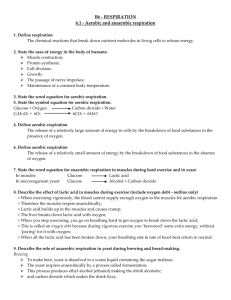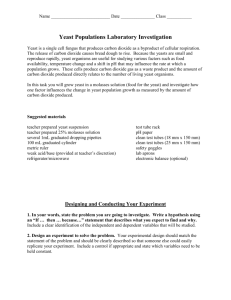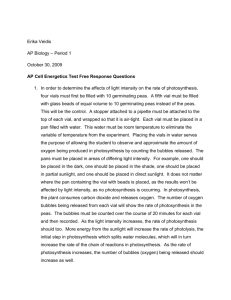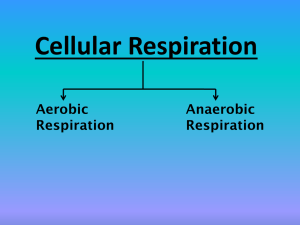Does temperature change affect the respiration of yeast
advertisement
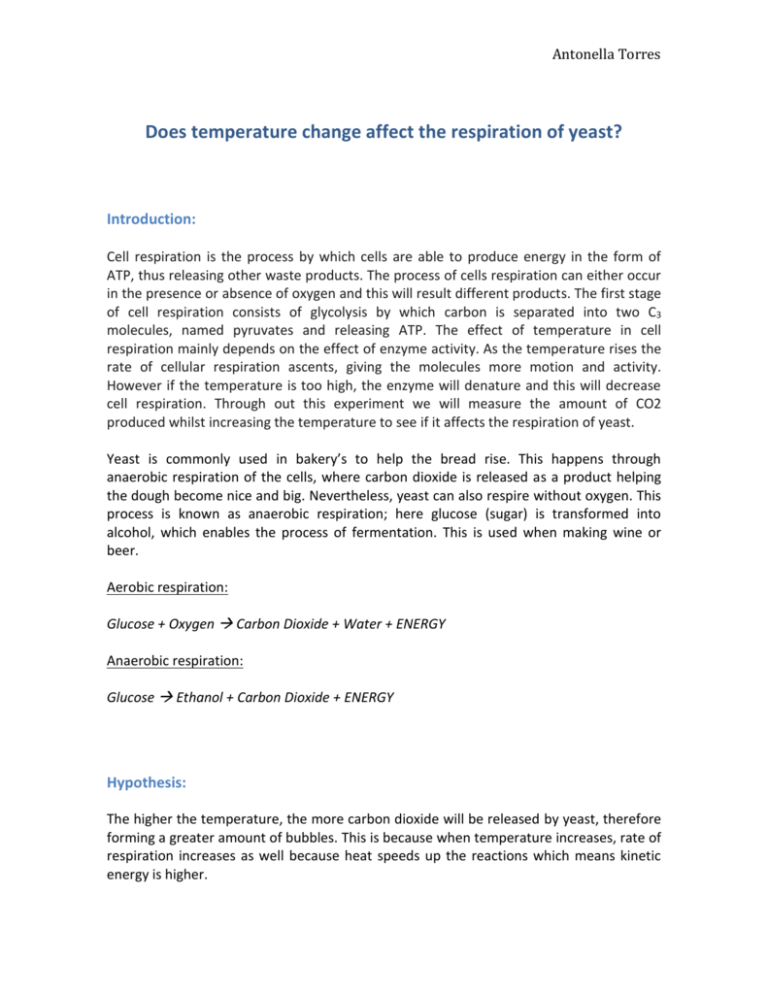
Antonella Torres Does temperature change affect the respiration of yeast? Introduction: Cell respiration is the process by which cells are able to produce energy in the form of ATP, thus releasing other waste products. The process of cells respiration can either occur in the presence or absence of oxygen and this will result different products. The first stage of cell respiration consists of glycolysis by which carbon is separated into two C3 molecules, named pyruvates and releasing ATP. The effect of temperature in cell respiration mainly depends on the effect of enzyme activity. As the temperature rises the rate of cellular respiration ascents, giving the molecules more motion and activity. However if the temperature is too high, the enzyme will denature and this will decrease cell respiration. Through out this experiment we will measure the amount of CO2 produced whilst increasing the temperature to see if it affects the respiration of yeast. Yeast is commonly used in bakery’s to help the bread rise. This happens through anaerobic respiration of the cells, where carbon dioxide is released as a product helping the dough become nice and big. Nevertheless, yeast can also respire without oxygen. This process is known as anaerobic respiration; here glucose (sugar) is transformed into alcohol, which enables the process of fermentation. This is used when making wine or beer. Aerobic respiration: Glucose + Oxygen Carbon Dioxide + Water + ENERGY Anaerobic respiration: Glucose Ethanol + Carbon Dioxide + ENERGY Hypothesis: The higher the temperature, the more carbon dioxide will be released by yeast, therefore forming a greater amount of bubbles. This is because when temperature increases, rate of respiration increases as well because heat speeds up the reactions which means kinetic energy is higher. Antonella Torres Variables: Independent: The changing temperatures of the water bath Dependent: Amount of Carbon Dioxide released in 1 minute (number of bubbles) Control: Same amounts of yeast (5ml) and glucose (10ml) solution Same period of time for counting the number of bubbles for each temperature, in this case 1 minute Covering each test tube with solution inside, completely with the hot water Experimental Design: Delivery tube Thermometer Carbon dioxide coming out as bubbles in water Test tube fitted with bung with glucose solution and yeast. It is important that the water covers all solution Hot water starting at 60 degrees Celsius Antonella Torres Stopwatch Pipettes used to measure 5ml of yeast and 10ml of glucose Dried yeast Test tube rack Materials and Equipment: Water Bath Dried Yeast (48gm yeast 0.6dm3) Thermometer Timer Test tube rack Test tubes (one fitted with bung) Delivery tube Rubber connection and jet Glucose solution (5%) Big beaker (400cm3) Method: 1. Gather all of the apparatus required to set up a water bath 2. In a 400cm3 beaker pour 200ml of hot water Antonella Torres 3. With a thermometer measure the temperature of water until 60 degrees is reached and work down wards 4. Using a pipette pour 5ml of yeast and 10ml of 5% glucose solution 5. Avoid mixing or shaking the test tube 6. Deposit the test tube in water bath covering it with a bung and its delivery tube 7. At the other end of the delivery tube, place another 400cm3 beaker with tap water where the carbon dioxide bubbles will be seen as product. 8. With a timer record the number of bubbles you see every minute 9. Repeat steps 2-8 but with 50, 40, 30 and 20 degrees 10. Record your results Results and process: Temperature (Degrees Celsius) Number of bubbles produced in 1 minute (CO2 released) 0 0 3 6 30 20 30 40 50 60 Graph: Does temperature change affect the respiration rate of yeast? 7 Number of bubbles 6 5 4 Number of bubbles produced in 1 minute (CO2 released) 3 2 1 0 -1 0 20 40 Temperature 60 80 Antonella Torres Conclusion: In conclusion, our hypothesis was supported to some extent because our results clearly show how the number of bubbles released at 60 degrees was the highest compared to other lower temperatures. The graph shows a rising slope; where at 20 degrees no bubbles were emitted in comparison to 60 degrees. The difference is quite staggering and there is not a periodic increase in number of bubbles, this might be due to errors in the experiment. The yeast respires rapidly at higher temperatures than at lower and this can be explained due to the kinetic theory. At higher temperatures more heat energy is provided to the particles and they would move faster having more collisions in a certain amount of time (1 minute). Nevertheless 60 degrees is a pretty high temperature for respiration to occur as enzymes would denature causing them to be unable to bind with the yeast and glucose particles but in this case we could say that the test tube was just beginning to heat up with the yeast and so the actual temperature inside was not 60 degrees at all. Therefore, most of the CO2 was released here. Probably the optimum temperature for respiration of yeast would be between 40-50 degrees. Evaluation: Errors: We did not repeat our results enough times to get a proper average and therefore our results are unreliable. We moved the test tubes around a lot and this biased the results for our respiration A proper water bath was not used so the temperature was not controlled precisely. 30 bubbles produced at 60 degrees could be seen as an anomaly as it is a lot of bubbles compared to the rest of the results, this was because the yeast was cold and it was just starting to heat up. This biased our experiment Try with yeast at room temperature as the one used was previously left on the fridge The yeast and glucose mixture was not the same temperature as of the water Antonella Torres Proposed modifications: Find an optimum respiration temperature for yeast which could be between 40 and 50 degrees, it would be nice to try the experiment for example at 45 degrees. Repeat results twice or three times to get mean Give more time for the respiration to occur. At least more than 1 minute. To be sure our solutions were not contaminated we could have worked in a much cleaner space, further away from other experiments We could have used more precise pipettes to have the correct amounts of solutions Next time we could try with a different type of yeast, not only dried yeast


